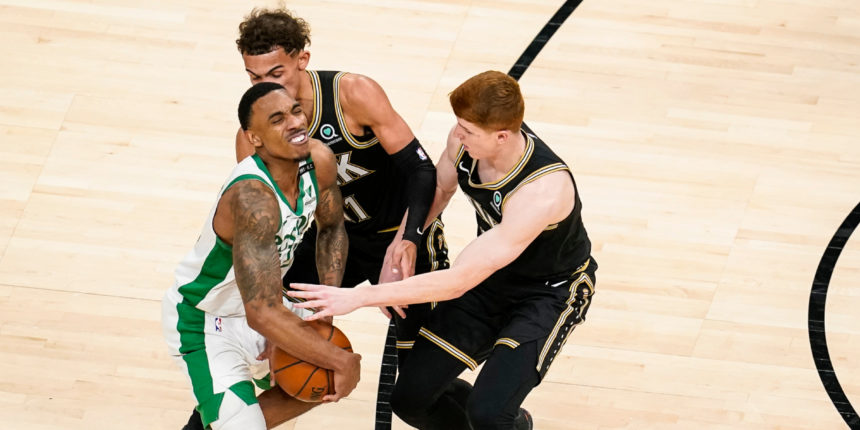It's official: the Boston Celtics have a ball movement
problem.
Most armchair coaches who have watched the Celtics this season
lob that complaint every time Jayson Tatum takes a stepback
three-pointer or Jeff Teague dribbles aimlessly around the
half-court. The C's are under .500 after dropping four of five
games out of the All-Star break. For fans, it's easy to yell at
players through the TV or streaming device and preach unselfishness
and teamwork.
Cherry-picking individual plays can lead to confirmation bias
and a warped view of how basketball works. But this time the
numbers back up the narrative. Boston simply does not produce with
its passing or score effectively one-on-one. There might be too
much to fix by Thursday's trade deadline.
The Celtics are 19th in the NBA in scoring at 111.7 points per
game, which lines up fairly close to their 17th spot in the league
standings. Boston hit something close to a seasonal rock bottom on
Friday night, when the squad put up just 96 points in a losing
effort against the Sacramento Kings and their historically bad
defense.
Celtics players assisted on 66.7 percent of the team's
three-point makes in the defeat. That's a low rate, and it lines up
with their 70.3 percent season-long ratio, which is second-lowest
in the NBA and above only the Portland Trail Blazers. Nearly 30
percent of Boston's three-point makes are unassisted. Almost half
(45.5 percent) of the team's total field goals are unassisted --
third-most in the entire league.
Nevermind their low assist numbers; the Celtics also log the
second-fewest hockey assists per game (2.0) and third-fewest
potential assists (passes that lead to a field goal attempt) with
39.6 per game. Their 1.60:1 assist-to-turnover ratio also ranks
near the bottom of the league. Brad Stevens is leaning on his
players to create looks for themselves, and the Celtics don't have
the scorers to do it.
Let's dive into this isolation play. According to the NBA's
statistics database, Boston runs about nine isolation possessions
per game. It's not a lot -- just 8.1 percent of the total
possessions -- but it ranks sixth-highest in the
Association.
But the Celtics are not the Brooklyn Nets and Portland Trail
Blazers, who are two of the best iso teams in basketball. Boston is
tied for the sixth-worst efficiency, with 0.84 points per
possession in isolation. That's also the lowest among teams with at
least seven iso plays per game.
Leading the downward spiral is, unfortunately, Jayson Tatum. The
young superstar has spent 171 possessions in isolation (eighth-most
in the NBA) and averages 0.83 points per possession (ninth-worst
among players with at least 50 total possessions).
Jaylen Brown is not faring much better in his 67 isolation
scenarios, at just 0.75 points per possession. Kemba Walker has
been used sparingly in isolation, while Jeff Teague comes off the
bench to do Jeff Teague things. Payton Pritchard has been the only
remotely successful iso player, and that's in his tiny 15-play
sample size.
So the Celtics' go-to players are not getting buckets in
isolation, nor are they facilitating. It gunks up the
drive-and-kick style that the C's and many modern NBA teams
appreciate.
The over-dribbling extends beyond the specific iso situations.
When Tatum takes three or more dribbles before attempting a shot --
which happens on over half of his attempts -- he makes it just 40.2
percent of the time (and only 32.8 percent on threes). Tatum is
lethal when he doesn't
dribble a lot. But his efficiency rapidly declines the more he
dribbles and the longer he holds onto the ball.

Then, there's Teague. As Celtics fans have learned, the speedy
veteran is an over-dribbling wizard. When Teague takes at least
three dribbles before shooting, his field goal percentage plummets.
Walker might be the most confounding case. Cardiac Kemba takes
the most three-pointers per game on the team, and almost 55 percent
of his makes are unassisted. So more than half the time,
Walker is having to create these shots himself. In fact, nearly 40
percent of Walker's shot attempts come after the point guard has
taken seven or more dribbles. How's he doing in those moments?
Well... he's shooting 34.7 from the floor.
Stevens has historically leaned on guards who can get their own
-- just look at Kyrie Irving and Isaiah Thomas. In their peak years
with Boston, both could get any shot they wanted on a basketball
court, which opened up playmaking opportunities. Walker is a great
scoring guard. He is neither of those players at this point in his
career.
Iso-ball can work. The aforementioned Blazers are a great
example of a non-super team that relies on self-creation even more
heavily than the Celtics. Terry Stotts lets Damian Lillard be
Damian Lillard, and with a number of other solid scorers, the
Blazers have the fifth-best offensive rating in basketball and are
the second-most effective isolation team.
Stevens is trying to find that go-to catalyst who threatens
defenses with his scoring package and dishes the ball when the
defense hones in. But none of the Celtics' three stars seem up to
the task right now.
Does the roster construction match Stevens' coaching style? If
not, will the coach or the core pieces be able to adjust?
That's the scary question that looms ahead of the trade
deadline.
:filters:quality(95)/images/story/2161/15744994_lg_690w.jpg)

:filters:quality(95)/images/assets/BasketballNews-Beta%403x.png)